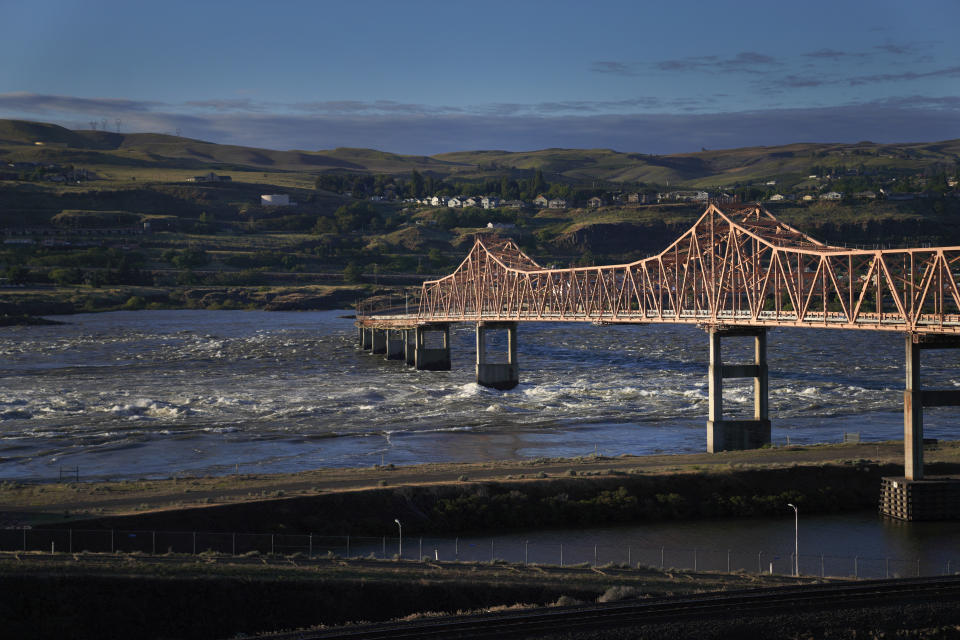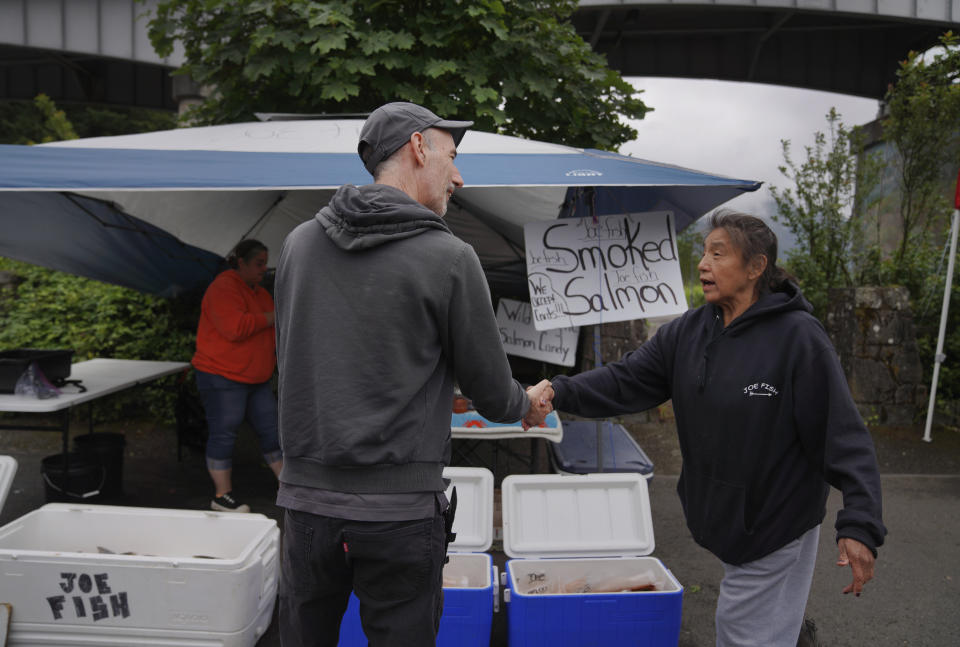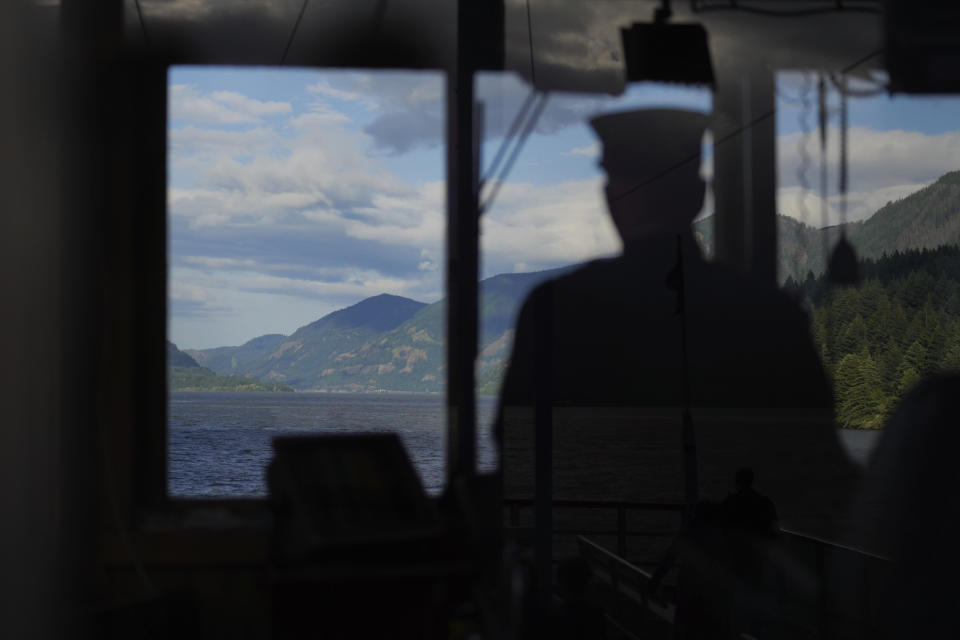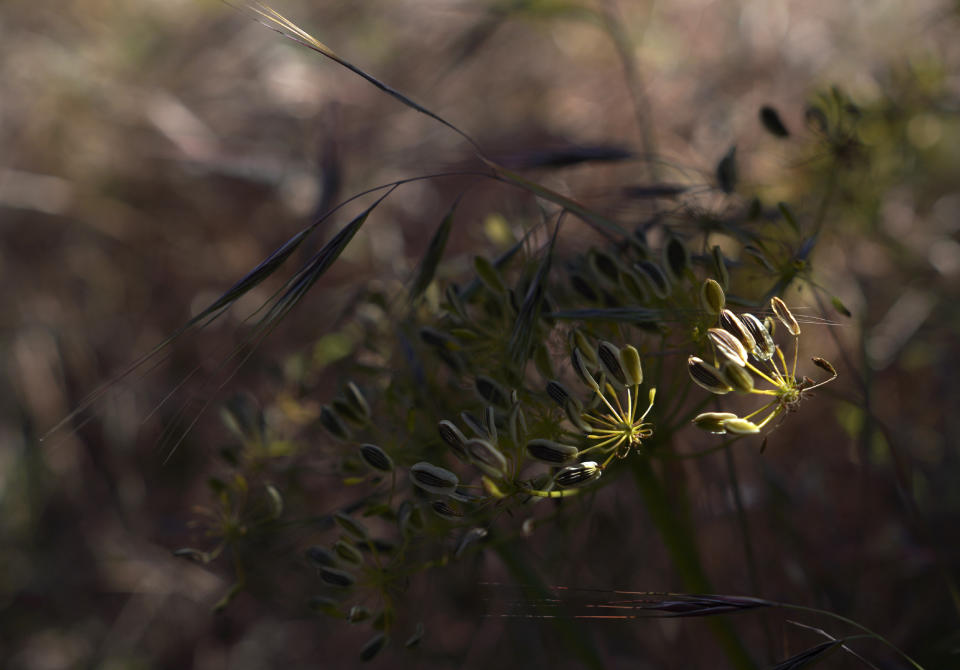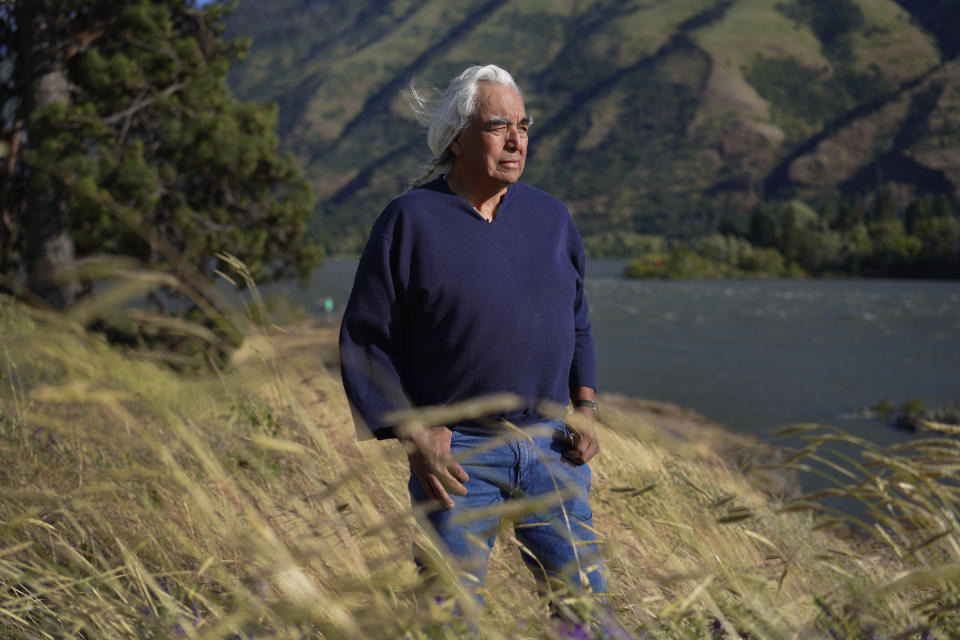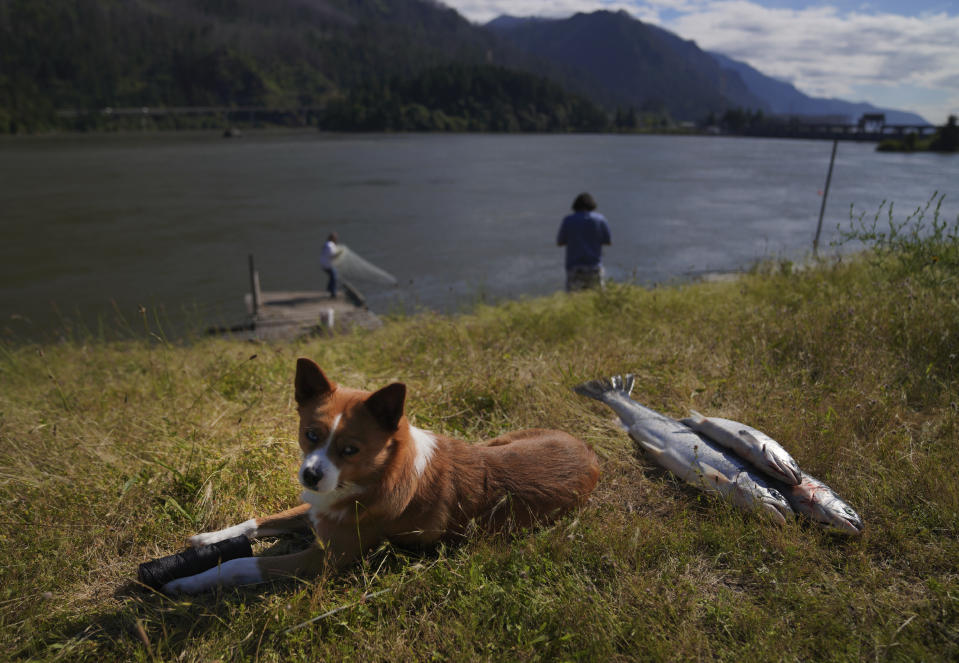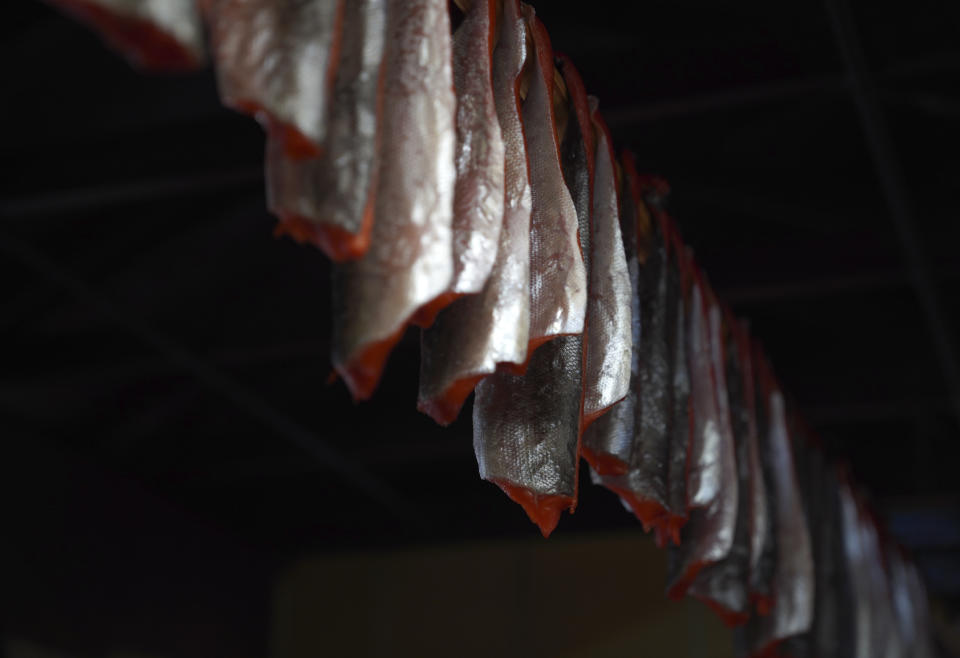Columbia River's salmon are at the core of ancient religion
ALONG THE COLUMBIA RIVER (AP) — James Kiona stands on a rocky ledge overlooking Lyle Falls where the water froths and rushes through steep canyon walls just before merging with the Columbia River. His silvery ponytail flutters in the wind, and a string of eagle claws adorns his neck.
Kiona has fished for Chinook salmon for decades on his family’s scaffold at the edge of the falls, using a dip net suspended from a 33-foot pole.
“Fishing is an art and a spiritual practice,” says Kiona, a Yakama Nation elder. “You're fighting the fish. The fish is fighting you, tearing holes in the net, jerking you off the scaffold.”
He finds strength, sanctity, even salvation in that struggle. The river saved Kiona when he returned from Vietnam with post-war trauma, giving him therapy no hospital could.
When he lies on the rocks by the rushing river and closes his eyes, he hears the songs and the voices of his ancestors. The water, he says, holds the history of the land and his people.
“It heals you.”
___
From its headwaters in British Columbia where the Rocky Mountains crest, the Columbia River flows south into Washington state and then westward and into the Pacific Ocean at its mouth near Astoria, Oregon. Just below the confluence with the Snake River, the Columbia’s largest tributary, the river turns through the Cascade Mountain Range, carving out the Columbia River Gorge.
It’s a spectacular canyon, 80 miles long and up to 4,000 feet deep, with cliffs, ridges, streams and waterfalls. For thousands of years, Native tribes in this area have relied on Nch’i-Wána, or “the great river,” for its salmon and steelhead trout, and its surrounding areas for the fields bearing edible roots, medicinal herbs and berry bushes as well as the deer and elk whose meat and hides are used for food and ritual.
Yet the river is under threat because of climate change, hydroelectric dams and industrial pollution. Warming waters linked to climate change endanger the salmon, which need cooler temperatures to survive. Hydroelectric dams on the Columbia and its tributaries have curtailed the river’s flow, further imperiling salmon’s migration from the Pacific upstream to their freshwater spawning grounds, and threatening millenia-old spiritual traditions that bind these Native communities together.
___
“We are the salmon people or river people,” says Aja DeCoteau, executive director of the Portland-based Columbia River Inter-Tribal Fish Commission, which represents the interests of the four Columbia River treaty tribes — Yakama, Umatilla, Warm Springs and Nez Perce — in policy, advocacy and management of the basin. “Without water there are no fish, plants or herbs.”
Each year the tribes honor the salmon, roots, berries, deer and elk — which they believe were originally placed in the land for their sustenance — with what are known as “first food ceremonies.” In their creation story, the salmon, deer, elk, roots and berries offered to provide sustenance to humans, and humans in turn were given the responsibility by the Creator to care for these resources.
Elders speak of how streams flow from the mountains sanctified by the prayers of ancestors who went there to commune with the spirits. These rivulets then flow down and merge with the Columbia. If Nch’i-Wána is the main artery of the land, those streams are like the veins that feed it. So even the smallest creek is vital and sacred.
At communal meals, tribe members typically begin and end with water — “You take a drink of water to purify yourself before you eat and you end the meal with water to show respect for what you’ve eaten,” DeCouteau says.
Tribes also use the river’s water and rocks for rituals such as sweat lodge purification ceremonies, held in low, dome-shaped structures where river rocks are heated along with herbal medicine.
“After you sweat and pray, there is also the practice of jumping in the river to cleanse yourself,” DeCouteau says. “It’s hard to continue practicing these rituals when the river is so contaminated.”
___
Bill Yallup Jr. was 6 when Celilo Falls “drowned,” as he puts it.
Known as Wyam to Native people, the thundering cascade was a sacred place where for 15,000 years Indigenous tribes netted salmon as the fish jumped upstream. It was also their economic nerve center, with the salmon trading for all manner of goods from feathers to copper to wampum, beads crafted from shells.
The falls fell silent in 1957 when the U.S. Army Corps of Engineers erected The Dalles Dam, flooding the area and creating the Celilo Lake reservoir.
Young salmon, or smolts, swim down the Columbia to the ocean, where they grow for between one and five years. Then they migrate back upstream to spawn. Some are caught and become a source of sustenance for the people, and others die and become one with the environment. The cycle repeats over and over.
“The sacredness of this river,” Yallup says, “lies in the sacrifice the salmon make each time they fulfill their promise to come back.”
___
It was worries over the spring salmon’s disappearance from the river that inspired Elaine Harvey to get her bachelor’s degree in aquatic and fishery science. She is also concerned for species like the Pacific lamprey, which has “been around since the dinosaurs” but today faces possible extinction.
Now a fish biologist for Yakama Fisheries, Harvey says what keeps her up at night is the “race to harness green energy” that has brought multinational corporations to the Columbia River.
“Wind turbines and solar farms are impacting our archeological sites, cultural resource sites, wildlife and fish,” she says, pointing to a sacred mountain near the John Day Dam that the Native people call Push-pum. “Our root fields are on that mountain. We could lose access to our food.”
Harvey says she will never leave the river because that’s what she was taught by her elders.
“We have a real, deep connection to all these places. Our blood line is here.”
___
Harvey’s cousin, Bronsco Jim Jr., was appointed mid-Columbia River chief when he was 21 and in that capacity performs longhouse services, first food ceremonies and funerals.
Sunlight streams into the longhouse during a recent ceremonial meal with elders at historic Celilo Village. Jim is wearing shell earrings and a beaded necklace with the pendant of a horse’s silhouette honoring his ancestors who rode them.
In Native families that inhabit the Columbia Basin, education about first foods begins at home and continues in these longhouses, accompanied by teaching and ceremony. Deeply held beliefs also dictate the rules of food gathering.
Community members are required to wait for that first feast to honor each food before they head out to harvest it. In the longhouse and out in the mountains, the food-gathering is accompanied by song.
“These songs and ceremonies are part of everything we do,” Jim says, adding that losing them could cost his people their spiritual identity.
“They feed our body and soul.”
Associated Press religion coverage receives support through the AP’s collaboration with The Conversation US, with funding from Lilly Endowment Inc. The AP is solely responsible for this content.


